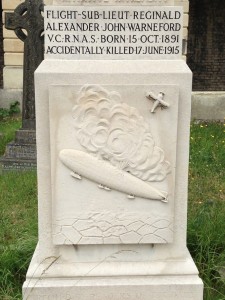
In Brompton Cemetery stands a wonderful monument to Reginald Warneford, the first man to destroy a Zeppelin in combat, over Belgium on 7 June 1915. He didn’t shoot it down, but dropped bombs on it – the resulting explosion almost killing him in the process.
Warneford’s own account provides lots of colour:

“I left Furnes at 1:00 am on 7th June 1915 … under orders to look for Zeppelins and attack the Berchem St Agathe Airship Shed with six 20lb bombs.
On arriving at Dixmude at 1:15 am, I observed a Zeppelin … and proceeded in chase… I arrived at close quarters a few miles past Bruges at 1:50 am and the Airship opened heavy maxim fire, so I retreated to gain height and the Airship turned and followed me. At 2:15 am it stopped firing and 2:25 am I came behind, but well above the Zeppelin; height then 11,000 feet, and switched off my engine to descend on top of him. When close above him at 7,000 feet I dropped my bombs, and … there was an explosion which lifted my machine and turned it over. The aeroplane was out of control for a short period, went into a nose dive, but control was regained. I then saw the Zeppelin was on the ground in flames.”
It didn’t end there. Warneford’s fuel pump was damaged and he had to land behind enemy lines. Realising that the Germans hadn’t spotted him he spent the next quarter of an hour fixing the plane. Once done, he took off and returned to base.
On 31 May 1915 the first Zeppelin raid on London had taken place (the airship Warneford downed was returning from such a raid on the capital) and the reaction to the destruction of LZ 37 should be seen in this context. Although strategically irrelevant, the outrage caused, as well as the symbolic importance of these attacks on the heart of the Empire was significant. There was also a sense of impotence, as the raiders were attacking with impunity – early-War fighters could not reach the altitude of the Zeppelins and their guns were useless against them. Warneford’s achievement was therefore a huge morale boost, striking back against the German ‘baby killers’ and their terror raids.
The recency of the London attacks (plus his undoubted bravery) may be why Warneford was awarded the Victoria Cross almost immediately; he received a telegram from the King on 8 June, just the day after the encounter, and was presented with the French Legion d’Honneur on the 17 June. But it was after this ceremony in Paris that Warneford died, when the aircraft he was flying (a new ‘plane) suffered a catastrophic wing failure in mid-air. Both Warneford and an American journalist who was a passenger in the craft, were killed.
Warneford was buried with full Naval honours (he flew with the Royal Naval Air Service) in Brompton Cemetery on 21 June 1915. Contemporary press reports speak of 50,000 people attending the service, and film and photos of the event show huge crowds.
The memorial “Erected by readers of the Daily Express” is Grade II listed and believed to be the first depiction of aerial combat on a public memorial.
The plane-spotters among you might like to note the mistake on the tableau – it shows the attacking aircraft as a biplane. Warneford was flying a Morane-Saulnier monoplane.
Sources and further information:


